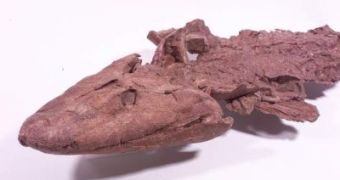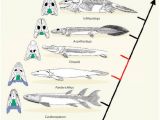One of the most fascinating evolutionary stories is the story of how the fish grew four legs and eventually turned into land animals. What makes this story so interesting is that it exemplifies a basic non-intuitive feature of how evolution works. Everyone can understand that something, like an organ, gradually changes in order to better fit a certain job, but often this is not what happens in evolution. It's not the function that creates the organ, it's the organ that creates the function. The organ often develops for some reason, being part of something or whatever, and at some point it starts to have a new function, its own function. Thus, the organs are not like some sort of tools developed to fit some predetermined purpose inside the organism.
The evolution of tetrapodes (the four legged animals, from frogs and dinosaurs to birds and humans) from fish exemplifies this process twice: first when the legs and fingers were developed, and they were not developed for walking; and second when the ears were developed, and they were not developed for hearing.
Now scientists have found the missing link between an already known fish, called Panderichthys (which lived 385 million years ago), and the tetrapods Acanthostega and Ichthyostega (which lived 365 million years ago). The newly discovered animal has lived about 375 million years ago and is called Tiktaalik roseae.
"I would say it's a key transitional form in the fish-to-land animal transition," said study co-author Neil Shubin of the University of Chicago. "It has features of both fish and tetrapods - we call it a 'fishapod.'"
The team discovered several well-preserved fossils having a length ranging from 1 meter to 2,75 meters, from nose to the estimated tail, in the layered rock in Ellesmere Island in Canada. The site today is almost 1000 kilometers above the Arctic Circle, but 375 million years ago it was near the equator. "Outside, it's a classic Arctic scene," Shubin said. "But inside those rocks is a tropical world."
On the fish side, Tiktaalik had gills, a fish-like jaw, and scales. However, it had a mobile neck and it could lift its head above water. Its crocodile like snout suggests it probably bit its prey, rather than sucking on it like a fish. Moreover, it was probably capable of supporting its own weight under water. The animal probably lived in shallow streams.
"If you look at joints of limbs, you can tell that the thing could perform a fish version of a push-up," said Shubin. "It could bend its elbow and flex its wrist. It was certainly capable of supporting its body underwater, in the shallows, or in mudflats with its limbs."
However, the animal was incapable of actually walking because it could not rotate its shoulders, so he must have dragged its body around like a sort of seal.
Here is how the lineage from fish to four-legged land animals, ranging from 385 million to 365 million years ago, looks like, according to Nature:
Credits: fossil photo (Ted Daeschler); drawing (Nature).

 14 DAY TRIAL //
14 DAY TRIAL // 
